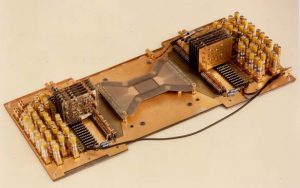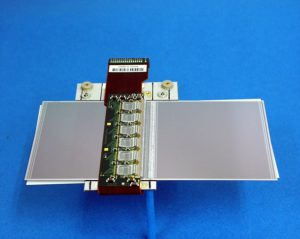11 mei 2017
The 2017 High Energy and Particle Physics Prize of the EPS for an outstanding contribution to High Energy Physics is awarded to Erik H.M. Heijne, Robert Klanner, and Gerhard Lutz “for their pioneering contributions to the development of silicon microstrip detectors that revolutionised high-precision tracking and vertexing in high energy physics experiments”.
Silicon microstrip detectors are at the heart of nearly every High Energy Physics detector today. They have played an enabling role in elucidating the mechanism of electroweak symmetry breaking, scrutinising the Standard Model using heavy quarks (charm, bottom and top), and precision measurements of quark and boson masses.
The development of planar passivated silicon diodes by the late Josef Kemmer (1938 – 2007) was a ground-breaking milestone in silicon microstrip detector technology. The fabrication of the first silicon microstrip detector using the planar process was demonstrated nearly simultaneously in the early 1980s by a team with Erik H.M. Heijne and independently by Robert Klanner and Gerhard Lutz.
The practicability of the first silicon microstrip detectors for High Energy Physics was demonstrated by Erik H.M. Heijne (former Nikhef scientist) and the late Bernard Hyams (1925 – 2015). In parallel, a group from Pisa led by the late Aldo Menzione (1943 – 2012) demonstrated a multi-electrode silicon detector produced by a surface barrier technology.
In 1982, the NA11 collaborators, Robert Klanner and Gerhard Lutz, in collaboration with Josef Kemmer, constructed a silicon telescope with six detectors. Soon after the first pion interaction with a secondary D meson decay vertex, reconstructed with the silicon microstrip detector telescope, was observed. This became the most convincing piece of evidence for the high energy and particle physics community of the far-reaching potential of the silicon microstrip detector.
The practicability of the first silicon microstrip detectors for High Energy Physics was demonstrated by Erik H.M. Heijne (former Nikhef scientist) and the late Bernard Hyams (1925 – 2015). In parallel, a group from Pisa led by the late Aldo Menzione (1943 – 2012) demonstrated a multi-electrode silicon detector produced by a surface barrier technology.
In 1982, the NA11 collaborators, Robert Klanner and Gerhard Lutz, in collaboration with Josef Kemmer, constructed a silicon telescope with six detectors. Soon after the first pion interaction with a secondary D meson decay vertex, reconstructed with the silicon microstrip detector telescope, was observed. This became the most convincing piece of evidence for the high energy and particle physics community of the far-reaching potential of the silicon microstrip detector.
Since these early days of operation, silicon microstrip detectors have undergone vigorous development in the particle physics community to become an essential part of all HEP experiments.
The pioneering work was carried out by E. H. M. Heijne working at CERN, and R. Klanner and G. Lutz at the Max – Planck – Institute of Physics in Munich. Later R. Klanner took positions at Hamburg University and DESY. Robert Klanner has been an Emeritus Professor since 2010. Gerhard Lutz works at the Semiconductor Laboratory of the Max Planck Institutes for Physics and Extraterrestrial Physics. Erik H. M. Heijne is with CERN and the Institute of Experimental and Applied Physics, Czech Technical University, Prague.


Source: http://www.eps.org/